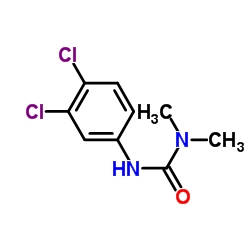Diuron

Diuron structure
|
Common Name | Diuron | ||
|---|---|---|---|---|
| CAS Number | 330-54-1 | Molecular Weight | 233.094 | |
| Density | 1.3±0.1 g/cm3 | Boiling Point | 362.3±52.0 °C at 760 mmHg | |
| Molecular Formula | C9H10Cl2N2O | Melting Point | 158-159°C | |
| MSDS | Chinese USA | Flash Point | 172.9±30.7 °C | |
| Symbol |



GHS07, GHS08, GHS09 |
Signal Word | Warning | |
|
Environmental friendly method for urban wastewater monitoring of micropollutants defined in the Directive 2013/39/EU and Decision 2015/495/EU.
J. Chromatogr. A. 1418 , 140-9, (2015) The fate and removal of organic micropollutants in the environment is a demanding issue evidenced by the recent European policy. This work presents an analytical method for the trace quantification of 37 micropollutants including Priority Substances (Directiv... |
|
|
Physiological and biochemical responses of Synechococcus sp. PCC7942 to Irgarol 1051 and diuron.
Aquat. Toxicol. 122-123 , 113-9, (2012) Cyanobacteria are prokaryotic algae found in oceans and freshwaters worldwide. These organisms are important primary producers in aquatic ecosystems because they can provide essential food for grazers and herbivores. In this study, the physiological and bioch... |
|
|
Microfunnel-supported liquid-phase microextraction: application to extraction and determination of Irgarol 1051 and diuron in the Persian Gulf seawater samples.
J. Chromatogr. A. 1356 , 32-7, (2014) In the present work, microfunnel-supported liquid-phase microextraction method (MF-LPME) based on applying low density organic solvent was developed for the determination of antifoulings (Irgarol 1051, diuron and 3,4-dichloroaniline) from seawater samples. In... |
|
|
A new, sensitive marine microalgal recombinant biosensor using luminescence monitoring for toxicity testing of antifouling biocides.
Appl. Environ. Microbiol. 79(2) , 631-8, (2013) In this study, we propose the use of the marine green alga Ostreococcus tauri, the smallest free-living eukaryotic cell known to date, as a new luminescent biosensor for toxicity testing in the environment. Diuron and Irgarol 1051, two antifouling biocides co... |
|
|
Antifouling biocides in water and sediments from California marinas.
Mar. Pollut. Bull. 69(1-2) , 189-94, (2013) Irgarol 1051 is a common antifouling biocide and is highly toxic to non-target plant species at low ng/L concentrations. We measured up to 254 ng/L Irgarol in water and up to 9 ng/g dry weight Irgarol in sediments from Southern California recreational marinas... |
|
|
Risk assessment of herbicides and booster biocides along estuarine continuums in the Bay of Vilaine area (Brittany, France).
Environ. Sci. Pollut. Res. Int. 20(2) , 651-66, (2013) A 2-year study was implemented to characterize the contamination of estuarine continuums in the Bay of Vilaine area (NW Atlantic Coast, Southern Brittany, France) by 30 pesticide and biocide active substances and metabolites. Among these, 11 triazines (ametry... |
|
|
Development of an analytical method for the targeted screening and multi-residue quantification of environmental contaminants in urine by liquid chromatography coupled to high resolution mass spectrometry for evaluation of human exposures.
Talanta 146 , 694-706, (2015) The aim of this study was to develop an analytical method and contribute to the assessment of the Exposome. Thus, a targeted analysis of a wide range of contaminants in contact with humans on daily routines in urine was developed. The method focused on a list... |
|
|
Polymer monolith microextraction using poly(butyl methacrylate-co-1,6-hexanediol ethoxylate diacrylate) monolithic sorbent for determination of phenylurea herbicides in water samples.
Talanta 147 , 199-206, (2015) In this study, recently developed 1,6-hexanediol ethoxylate diacrylate (HEDA)-based polymeric monoliths were utilized as sorbents for efficient extraction of phenylurea herbicides (PUHs) from water samples. The HEDA-based monolithic sorbents were prepared in ... |
|
|
Chloroplasts extend stromules independently and in response to internal redox signals.
Proc. Natl. Acad. Sci. U. S. A. 112 , 10044-9, (2015) A fundamental mystery of plant cell biology is the occurrence of "stromules," stroma-filled tubular extensions from plastids (such as chloroplasts) that are universally observed in plants but whose functions are, in effect, completely unknown. One prevalent h... |
|
|
Influence of pesticide use in fruit orchards during blooming on honeybee mortality in 4 experimental apiaries.
Sci. Total Environ. 541 , 33-41, (2015) Samples of dead honey bees (Apis mellifera L.) were collected periodically from 4 different locations during citrus and stone fruit trees blooming season to evaluate the potential impact of agrochemicals on honey bee death rate. For the determination of morta... |